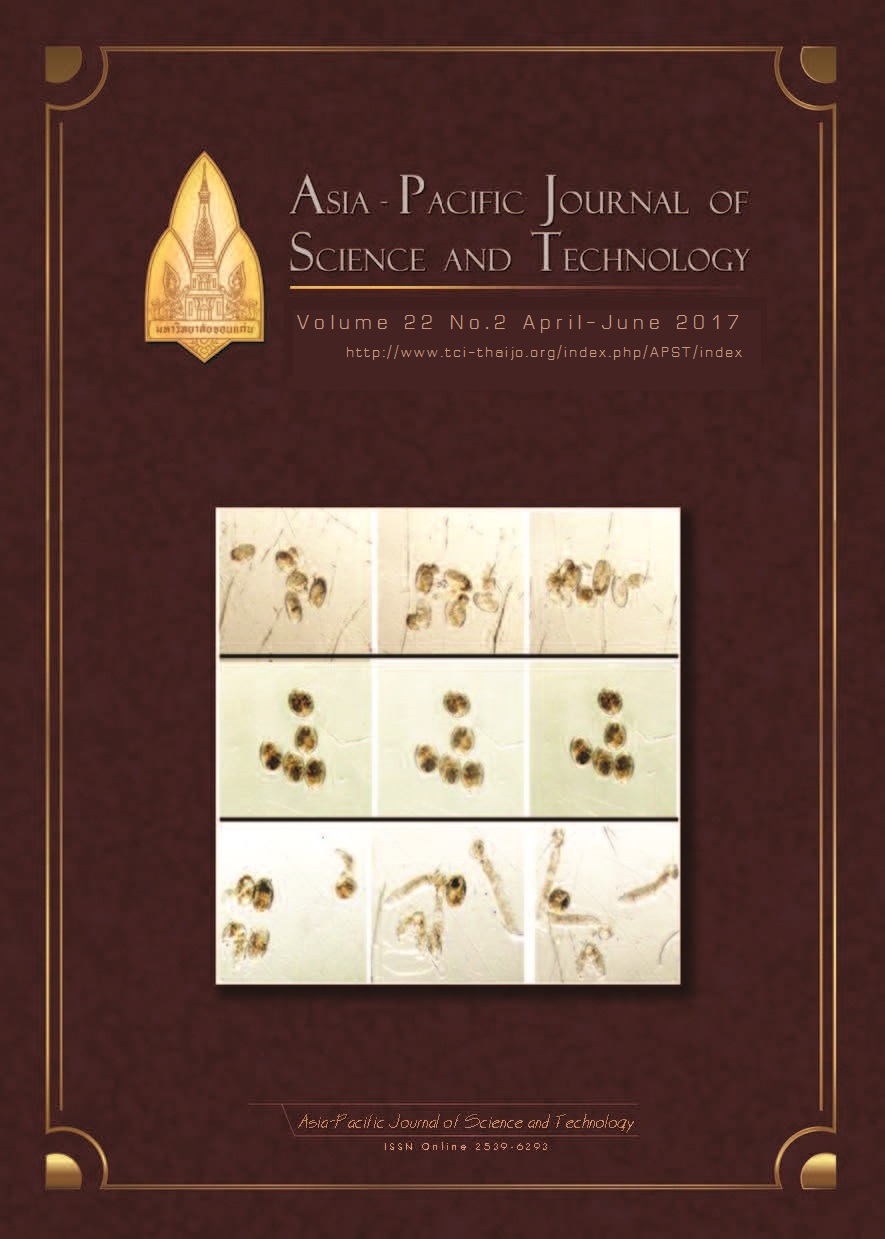Production and development of tomato crisps from tomato pomace
Main Article Content
Abstract
The production of a crispy snack made from tomato pomace is not only a way to increase the nutritional content of a food, but it can also increase the value of by-products from the tomato industry. The objective of this research was to produce a spicy tomato crisp that can be used in cereals. Tomato pomace from two tomato sauce factories in Nong Khai, Thailand, was used to prepare the tomato crisps. The results showed that spicy tomato crisps had higher consumer acceptance than the original or sesame tomato crisps. The tomato pomace used as a starting material was not significantly different in any of the treatments. The chemical composition of the tomato crisps with the highest acceptance showed values 8.58, 4.36, 2.14, 12.72, and 46.48% for protein, fat, fiber, ash, and carbohydrate, respectively. The lightness, red color, and yellow color values were 51.55, 13.68 and 27.50, respectively. The brittleness and crispiness of that sample were 1.248 mm to fracture and 13.03 N/mm, respectively.
Article Details
References
[2] Department of Agriculture. Tomato., 2010. [WWW Document]. URL http://www.doae.go.th, 3/3/2013. (accessed 3. 3. 10).
[3] Sanitwong Na Ayuthaya, J., 2010. The use of tomato pomace for animal feed [WWW Document]. URL http://www.dld.go.th, 3/3/2013. (accessed 3. 3. 10).
[4] Bobek, P., Ozdin, Hromadova, M., 1998. The effect of dried tomato grape and apple pomace on the cholesterol metabolism and antioxidative enzymatic system in rats with hypercholesterolemia. Nahrung 42, 317-320.
[5] Denek, N., Can, A., 2006. Feeding value of wet tomato pomace ensiled with wheat straw and wheat grain for Awassi sheep. Small Ruminant Research 65, 260-265.
[6] Peiretti, P.G., Gai, F., Rotolo, L., Brugiapaglia, A., Gasco, L., 2013. Effects of tomato pomace supplementation on carcass characteristics and meat quality of fattening rabbits. Meat Science 95, 345-351.
[7] Shao, D., Bartley, G.E., Yokoyama, W., Pan, Z., Zhang, P., Zhang, H., Zhang, A., 2013. Plasma and hepatic chlolesterol-lowering effects of tomato pomace, tomato seed oil and defatted tomato seed in hamsters fed with high-fat diets. Food Chemistry 139, 589-596.
[8] Savadkoohi, S., Hoogenkamp, H., Shamsi, K., Farahnaky, A., 2014. Color, sensory and textural attributes of beef frankfurter, beef ham and meat-free sausage containing tomato pomace. Meat Science 97, 410-418.
[9] Altan, A., McCarthy, K.L., Maskan, M., 2008. Twin-screw extrusion of barley-grape pomace blends: Extrudate characteristics and determination of optimum processing conditions. Journal of Food Engineering 89, 24-32.
[10] Stojceska, V., Ainsworth, P., Plunkett, A., Ibanoglu, E., Ibanglu, S., 2008. Cauliflower by-products as a new source of dietary fibre, antioxidants and proteins in cereal based ready-to-eat expanded snacks. Journal of Food Engineering 87, 554-563.
[11] Altan, A., McCarthy, K.L., Maskan, M., 2008. Evaluation of snack foods from barley-tomato pomace blends by extrusion processing. Journal of Food Engineering 84, 231-242.
[12] Selani, M.M., Brazaca, S.G.C., Dias, C.T.S., Ratnayake, W.S., Flores, R.A., Bianchini, A., 2014. Characterisation and potential application of pineapple pomace in an extruded product fir fibre enhancement. Food Chemistry 163, 23-30.
[13] Association of Official Agricultural Chemists (AOAC)., 2000. Official Methods of Analysis of AOAC International. AOAC International: Gaithersburg, MD, USA.
[14] Sun-Waterhouse, D., Teoh, A., Massarotto, C., Wibisono, R., Wadhwa, S., 2010. Comparative analysis of fruit-based functional snack bars. Food Chemistry 119, 1369-1379.


